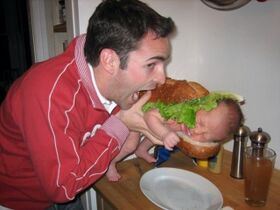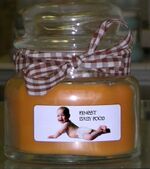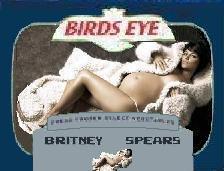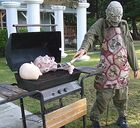Baby farming
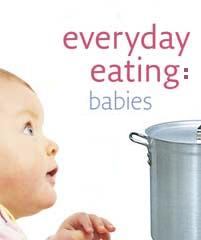
“I love infants, but I can't eat a whole one”
Baby Farming (an abuse) is the purposeful producing of human infants for the purpose of human consumption, generally as a foodstuff. This should not be confused with the closely related and much larger industry of baby harvesting, which is the gathering of unintentionally produced and generally unwanted infants for human consumption. Additionally, neither baby farming nor baby harvesting should not be confused with baby stealing, which is the theft of wanted infants for the purpose of consumption. Baby farming includes infants produced for both sale and personal use. The idea of using babies for foodstuff was first put forth by Johnathan Swift in his satirical work "A Modest Proposal" in 1729.
Baby farming is an industry worth approximately $125 million per year, producing over 250 thousand infants in 2006. In addition, some 50 thousand infants were produced for private consumption. The typical selling price of a baby is about $50, depending on weight, race, and gender. Some specially grown and bred gourmet babies can sell for several thousand dollars.
Unlike baby harvesting, baby farming has been practised in relatively few areas of the world. The high costs of baby farming combined with the near-universal surplus of unwanted infants has rendered it unprofitable except when baby flesh is a highly sought after luxury food.
The main types of baby farming are:
- industrial baby farming, also called plantation-type baby farming, in which several infants are produced on a large "farm" in an industrial setting for the purpose of sale
- non-industrial baby farming, or more precisely, commercial non-industrial baby farming, also called cottage-industry baby farming, in which a single female intentionally produces a baby for the purpose of sale
- non-commercial baby farming, in which a baby is produced for the purpose of personal consumption.
Today, almost all commercial baby farming, industrial or otherwise, occurs in the four nations of Cambodia, Laos, North Korea, and Vietnam. In former times, it was also practiced in most of eastern Asia and Ireland. Although almost all farmed babies are Asian, there is a niche industry in Vietnam in white and black babies, which were bred from captured soldiers from the Vietnam War.
In addition to their use as foodstuffs, babies are also used to create baby-leather and their organs are often transplanted into more desired infants. In southern Africa, babies are used as a traditional "cure" for aids, the effectiveness of which is questioned by modern science.
History[edit]

Mankind has been eating babies since before the dawn of civilization. The trading of infants as a food also dates back to before written records; however, it is generally believed that primitive man did not intentionally produce babies to eat, outside of a few isolated incidents.
The first records of actual baby farming appear in China in the 2rd century B.C.E. The baby farms are described as a relatively new concept, created in order to satisfy the demand for human flesh among the upper classes of Chinese society. Historically, Asiatic people have tended to eat more human flesh than other races. Older sources claim that Asians are biologically pre-desposed to cannibalism; however, most modern researchers have suggested the difference is mostly cultural.
Asian Baby Farming[edit]
Baby farming quickly became common across all of China, particularly in the north-western areas, and remained so into the 20th century. In some periods, it is estimated that up to half of the babies born in China were consumed in some fashion.
Western Baby Farming[edit]
Jonathan Swift is generally regarded as the inventor of baby farming in the West. For centuries, babies have been eaten in Europe, chiefly by Witches. However, like most baby eating, these acts should be classified as baby harvesting, if not baby stealing.
In his now famous Essay "A Modest Proposal: For Preventing the Children of Poor People in Ireland from Being a Burden to Their Parents or Country, and for Making Them Beneficial to the Publick", written in 1729, Swift merely suggested baby harvesting to rid Ireland of its overpopulation, not setting up baby farms. Initially, many people were shocked by the suggestion of Swift, but his arguments in favor of baby eating won the day, and in 1733, the eating of Irish catholic infants under 1 year of age was legalized by Parliament.
For several years, baby eating remained a taboo activity; known baby eaters would often be shunned by polite society. In 1737, Swift wrote a letter to the then Prime Minister, Sir Robert Walpole informing him of the sad state of affairs. Walpole was apparently moved by the letter, and convinced King George II to serve Irish baby at the Royal Christmas dinner that year. Within months, the Great English Baby-Eating Craze, as it would later be called, was in full swing. For the next 95 years, tens of thousands of Irish babies were devoured by the English Gentry every year, holding down the cost of land rental in Ireland and preventing widespread famine in that impoverished land.
During this time, Swift had established himself as a prosperous baby merchant, buying babies in Ireland and re-selling them in Britain. As the price of infants rose as the excess supply was being burned off, some feared that the high cost might tempt English parents to sell their children disguised as Irish babies. To the English of this period, the thought of eating another English person was highly revolting. To counter this fear, Swift proposed that baby farms, or baby plantations as he called them, be established in Ireland. On these baby plantations, babies would be bred and raised as livestock. Due to the high cost of using human beings as livestock, the cost of babies would remain high enough to prevent a surplus of Irishmen, yet low enough as to keep the illicit trade in non-Irish infants to a minimum.
In 1740, the first of many baby plantations was founded near Dublin with Jonathan Swift as the director. Despite the economic success of these baby farms, they only produced about 15% of the total infants consumed in Britain. The remaining 85% were mostly harvested unwanted infants, although a few Irish women did independently produce infants commercially. Baby farming remained restricted the Irish Catholics - selling a baby for the purpose of human consumption which was not both Catholic and Irish was punishable by death. Despite this restriction, some baby farming was introduced into Canada and South Africa.
Decline of Western Baby Farming[edit]
Although baby eating became an established custom in England, many opposed the practice. Among these were several prominent clergymen, (such as Whitefield and the Wesley brothers), reformist Whigs, most Catholics, and even King George III himself. Opposition to baby-eating spiked in the 1820's; and in 1832, the practice was outlawed. This resulted in rents rising over the next decade as the population of Ireland skyrocketed. It is now commonly believed that the the illegalization of baby farming in Ireland was responsible for the Irish potato famine. Baby trading was now a felony, regardless of creed or nationality of the infant, although harsher penalties for selling British protestant infants would remain in place until the 20th century.
Due to poor phrasing in the law, however, the eating of infants remained legal. This led many English families to adopt the practice of non-commercial baby farming. Each year, several upper-class women would get pregnant in January or February so that they would have a baby in time for Christmas dinner. This practice gradually fell in popularity throughout the 19th century, but the practice never went extinct. In recent years, there has been some resurgence in non-commercial baby farming, with such celebrities as Britney Spears, Katie Price, and Katie Holmes engaging in the practice. It has started to become popular with the lower and middle and upper classes of New York and any place in California
Decline of Eastern Baby Farming[edit]
At the turn of the 20th century, baby plantations existed in what is now China [People's Republic], both Koreas, Japan, Vietnam, Cambodia, Laos, Thailand, and Taiwan. In some nations, baby farming was outlawed; in Myanmar by the British in 1886, in the People's Republic of China in 1962, Taiwan following suit in 1963. In other nations, the rising standard of living forced baby farms out of business, the last baby farm in Japan closed in 1958, in South Korea, 1973, and in 1982 in Thailand.However in Russia, in the city of KFelfisdudhfegrad, baby farming is now the biggest and only industry in the city
Modern Industrial Baby Farming[edit]

Today, baby farming is limited to South-East Asia and North Korea. It was practiced in most of eastern Asia until the 20th century, but was either outlawed or rendered economically unfeasible by rising labor costs [no pun intended] and reduced demand for human flesh.
Most industrial baby farming still takes place in plantation-like barracks, often surrounded by a fence of some sort. Traditionally, the breeding women, called 'cows' in technical jargon, were forcibly held at the plantation, but these restrictions have been relaxed in recent years, especially in the 'cow has handed over several infants without incident.
Traditionally, all the employees of a baby farm, excluding the breeding women, have been male. This is due both to the male-dominated cultures and the belief that women are more likely to help the breeders or their children escape. This is still the case in most areas, except in Cambodia were a few women have been employed by the larger baby farms. Baby plantations have also traditionally hired a large number of young boys, as the much of the required work can be done by children.
Method of Breeding[edit]
In former times, many baby farms were combined with brothels to earn extra money. The breeding female would often be impregnated by a random client. Fortunately, the practice has long been abandoned for obvious health issues, in addition to other factors. Now, all baby farms use some sort of selective breeding to, at a minimum, assure that the babies produced are free of STDs. In all but the most primitive baby farms, conception in achieved through artificial insemination to prevent the spread of diseases.
Controlling infant size is among the most important concerns of modern baby farms, and is chiefly addressed by selective breeding. Overly large infants can result in difficult births, which greatly add to expenses of a baby farm. Generally, a weight of about 6 lb is preferred in South East Asia and 5.5 lb among the smaller east Asians. This is generally achieved by breeding the cows with men who had low birth weights. Alcohol or other medication and induced labor is also used to stunt the size of infants in the grow too large.
Another concern of baby farmers is to ensure a majority of female births, since in many areas of China, only female babies are eaten. Female babies are also preferred in the orient, where most systematically farmed babies are purchased. This is done by a variety of methods, often a 70-75% rate of female births is attained.
Work of Breeding Females[edit]
To work as a breeding female, one must be a fertile female, generally between the ages 18 and 35, although some older women are occasionally hired. Baby farms prefer the woman be unmarried and be as young as possible or have had previous experience in baby farming. Most baby farms require that prospective employees be about 8-9 months pregnant with a child they plan to sell. The birth will then be observed by a representative of the company to prove the baby is in fact the child of the perspective employee. After the birth, the mother will be watched for signs of regret for selling her baby. If no such signs are observed, she will generally be hired.If any regret is shown then they are forced to have many more babies until the regret is gone. In Germany this is the most popular wording along with Hilter's annaul birthday song, sung ever day "Leben Sie lang das Vaterland, ist Babyessen nationaler Sport mit Bier! Bierbabys!"
After being hired, the breeding female will be kept on the baby farm in a barracks-like living facility, often called a barn, with other breeding females. During this time, they will generally also be employed in the textile industry or some light manufacturing. In a few of the larger farms, some of the more attractive females will be utilized in the production of fetish pornography. For the most succulent, soft, tenderest babies you will ever eat, you must travel to Howahaka, a small island off the coast of Australia. There, the breeding females are fed their own babies while pregnant. This goes on until they have eaten at least five of their own babies, and ensures the best farmed babies in the world, the price ranging from $5000 and higher depending on the amount of babies eaten. The most expensive baby ever recorded was from this area costing $47000 -she ate 47 of her own babies- no joke youd have to be sick in the head to eat that baby. Due to their rich unmatchable flavor, export of these babies are illegal and you must go there to get one. You could buy one on the black market for quadruple price if you're that lazy.
Gourmet Babies[edit]

Gourmet babies are specially bred and raised infants, produced mainly in Laos, but formerly mostly in China. Gourmet babies are often confused with celebrity babies, as both are far more expensive than regular babies. A celebrity baby is defined as the infant of a famous person sold for human consumption, whereas a gourmet baby is a specially bred infants who parents are, in all likelihood, not well known. Gourmet babies are always raised on licensed baby plantations, while a celebrity baby is almost never grown on a baby farm. Despite the setback to this industry by the outlawing of baby farming in China, the gourmet baby industry has grown rapidly in recent years, while the baby farming industry as a whole has significantly contracted.
The cost of a gourmet baby can vary from a few hundred to several thousand dollars, depending on its pedigree. Gourmet babies are specially bred to have a milder, less gamy flavor, a more tender texture, and better marblization of fat and meat.
Like all domesticated livestock, gourmet babies are produced through selective breeding over several generations. In other words, some baby farms have saved the siblings of particularly delicious babies and used them for further breeding. The long period of time between generations has made selective breeding difficult. Additionally, up to a quarter of those people bred for baby farming decide to enter some other industry. Unlike common babies, which are mainly sold to other east Asian nations, gourmet babies are often sold to developed western nations.
Criticisms of baby farming[edit]
Many criticisms have been leveled at baby farming industry by various human rights groups. The most common accusations include:
- Forced labor. Although in earlier times, some women were forcibly held on the baby farms, this is rarely true currently. Although some women are held to prevent escape, all breeding females now enter that line of work voluntarily. The proponents of baby farming assert that their practices are no more 'forced labor' than western contracts for surrogate mothers.
- Low wages and long hours for employees of breeding farms.
- Purchasing farmed babies hurts the balance of trade of most nations. This is true because babies are only farmed industrially in four countries.
- Baby farms rarely, if ever, hire women for support staff roles. However, this ignores the fact that up to 80% of the employees of a baby farm are breeding females.
- Finally, a few people reject the idea of eating human infants on moral or religious grounds.
See also[edit]
- Baby food
- Baby-snatching
- Chinese Abortion Factories
- Fishing For Children
- Fishing For Children Photo Album
- Corpsearian
- Baby Meat
- HowTo:Cook A Fetus
| |||||||||||||||||||||||

